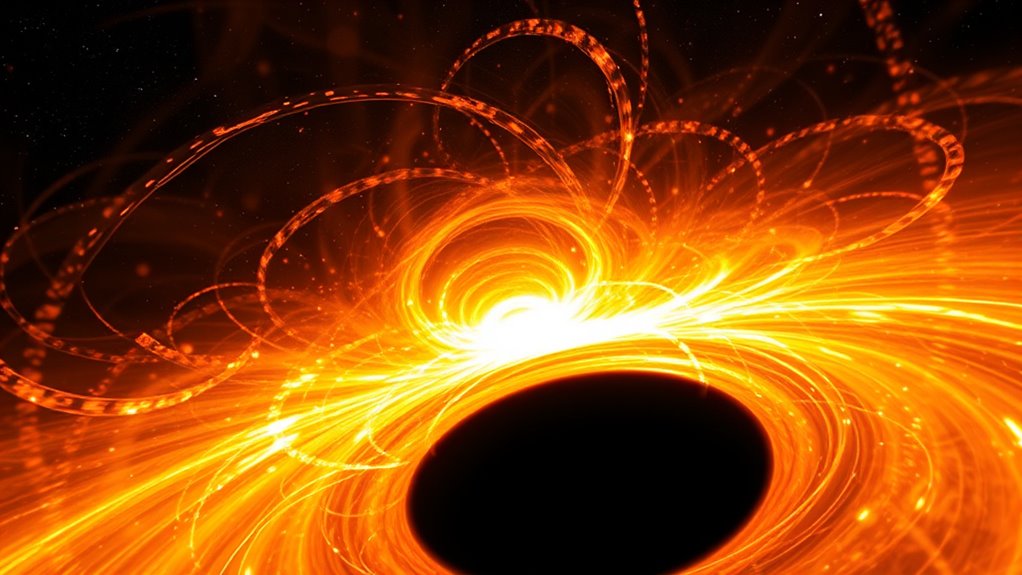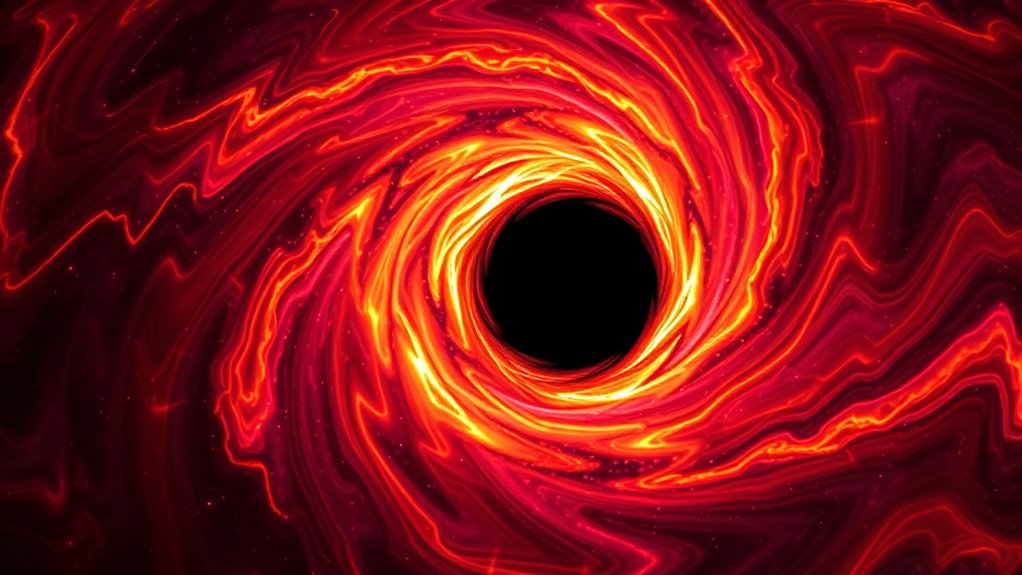Scientists have captured the clearest-ever image of a black hole’s accretion disk in motion, revealing detailed, dynamic views of swirling matter near the event horizon. Using advanced imaging technology and international collaboration, they visualized a luminous, pulsating disk with complex structures and high-energy jets shooting out from the poles. This achievement confirms important theories and offers new insights into black hole behavior, showing how matter accelerates and heats as it spirals inward. Discover more about these remarkable cosmic phenomena as you explore further.
Key Takeaways
- The image is the first clear visualization of a black hole’s accretion disk in motion, revealing dynamic swirling matter.
- Advanced imaging technology combined data from multiple telescopes to produce high-resolution, real-time observations.
- The disk shows pulsations, fluctuations, and complex structures as matter accelerates and heats near the event horizon.
- The image captures the structure of the accretion disk and jet launching points, confirming theoretical models.
- This achievement advances understanding of black hole behavior and demonstrates progress in high-resolution astrophysical imaging.

For the first time, astronomers have captured the clearest image yet of a black hole’s accretion disk, revealing details that were previously impossible to see. This breakthrough gives you an unprecedented view of the swirling matter spiraling into the black hole’s event horizon. As matter accelerates and heats up, it emits intense radiation, creating a luminous disk that encircles the black hole’s edge. This accretion disk isn’t static; it pulses and fluctuates, showcasing complex structures that help scientists understand how black holes grow and interact with their surroundings.
The image also exposes the dramatic phenomena associated with black holes—most notably, radiation jets that shoot out from the poles at nearly the speed of light. When you look at the image, you see these jets as narrow streams of high-energy particles, extending far beyond the black hole itself. These jets are powered by the intense magnetic fields generated near the event horizon, where gravity is so extreme that it distorts space and time. The process by which matter is funneled into these jets remains a key puzzle, but this new image offers clues by revealing the regions where magnetic forces and accretion flows intertwine.
What makes this image so significant is its ability to resolve the dynamics at the very edge of the black hole—the event horizon—where gravity is so intense that nothing, not even light, can escape. Previously, scientists could only infer the behavior near this boundary, but now, you can actually see the structure of the accretion disk and the launching points of radiation jets with remarkable clarity. This insight helps confirm theoretical models of black hole physics, especially how matter behaves as it approaches the event horizon. You can appreciate how the accretion process influences the formation of jets and the black hole’s growth over cosmic timescales.
This achievement is a testament to advances in imaging technology and international collaboration, combining data from multiple telescopes to produce an image with extraordinary detail. By observing these phenomena directly, you gain a better understanding of the fundamental laws of physics under the most extreme conditions known in the universe. The image not only illuminates the complex dance of matter and energy near a black hole but also pushes the boundaries of what we can observe and comprehend. With each new picture, you get closer to unraveling the mysteries of black holes, their event horizons, and the powerful radiation jets they produce.
Furthermore, this breakthrough highlights the importance of high-resolution imaging in astrophysics, enabling scientists to test and refine models of black hole behavior more effectively.
Frequently Asked Questions
How Does the Black Hole’s Magnetic Field Influence the Accretion Disk?
Your black hole’s magnetic field influences the accretion disk through magnetic dynamics and field interactions. It channels charged particles, shaping the disk’s structure and directing jets of energy away from the black hole. These magnetic forces can also cause turbulence and instabilities, affecting how matter spirals inward. By controlling the movement and behavior of plasma, the magnetic field plays a vital role in the evolution and observable features of the accretion disk.
What Future Technologies Might Improve Black Hole Imaging Accuracy?
Future technologies like quantum imaging could dramatically boost black hole imaging accuracy by reducing noise and enhancing resolution. As space weather impacts current observations, developing resilient instruments becomes vital. You might see advanced telescopes equipped with quantum sensors that counteract space weather effects, enabling clearer images. These innovations will let you explore black holes in unprecedented detail, revealing new insights into their behavior and the universe’s fundamental physics.
How Do Black Hole Jets Affect the Surrounding Galaxy?
Black hole jets can extend over a million light-years, dramatically impacting their galaxy. These jets, fueled by black hole accretion, push out material and energy, regulating star formation and galaxy growth. When black hole jets interact with surrounding gas, they can trigger or suppress star birth, shaping the galaxy’s evolution. This powerful process influences galaxy structure and the cosmic environment, highlighting black holes’ significant role in the universe.
Can This Image Help Detect Gravitational Waves From Black Holes?
This image can aid in gravitational wave detection by providing detailed views of black hole shadows and accretion disks. By analyzing the black hole’s shadow, you can better understand its mass and spin, which influence gravitational wave signals. Combining this visual data with gravitational wave observations helps refine models and enhances detection accuracy, giving you deeper insights into the dynamics of black holes and the ripples they create in spacetime.
What Are the Implications for Understanding Black Hole Formation?
You’re looking at a breakthrough that deepens your understanding of black hole formation. This image reveals detailed accretion physics, shedding light on black hole evolution. With over 6.5 billion solar masses, the black hole’s accretion disk illustrates how matter spirals inward, helping you grasp how black holes grow from stellar remnants to supermassive giants. This insight improves models of their birth, growth, and the role they play in galaxy development.
Conclusion
You’ve just seen how scientists captured the clearest image yet of a black hole’s accretion disk in motion. This breakthrough reveals the swirling chaos just outside the event horizon, with matter spiraling at nearly the speed of light. Did you know that this black hole’s disk spans over 100 billion miles? It’s incredible to think how such a vast, dynamic system exists so close to the unknown, pushing the boundaries of what we thought was possible to observe.









